Patreon CHORDS 101 Series
Triad Shapes Drills
- Page One -
Most
popular modern keyboard styles involve playing triads in the right hand, harmonising the top (melody) note.
So you need to practice seeing the three basic triad shapes (root position, first inversion and second inversion) below any top note in a key - and getting to them fluently.
Here's a sample 'Triad Shapes Drill' video. Watch it, then carry on reading the explanation below.
Three patterns
The video shows the three possible triad
shapes (root position, first
inversion and second inversion) played on each of the eight scale tones of C major, going up.
There are three patterns in the Triad Shapes Drills.
Study the three-line voice movement diagrams in the diagram until you see clearly the difference between the three types.
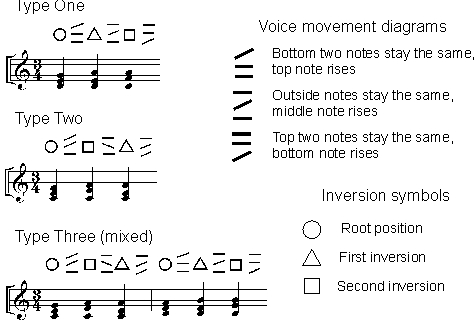
The voice movement diagrams show whether the notes of a triad stay the same or rise and fall to their positions in the next chord. This is very helpful in 'keeping track' of where the notes go.
Notice also that Musicarta uses circle, square and triangle symbols to indicate the three inversion shapes - root position, second inversion and first inversion respectively.
Refer visually to the symbols from time to time – it helps distinguish the three inversion shapes more clearly in your mind, and you will in time be able to 'hear' which triad shape is being played.
Watch the sample video again.
Pattern One ascending in C
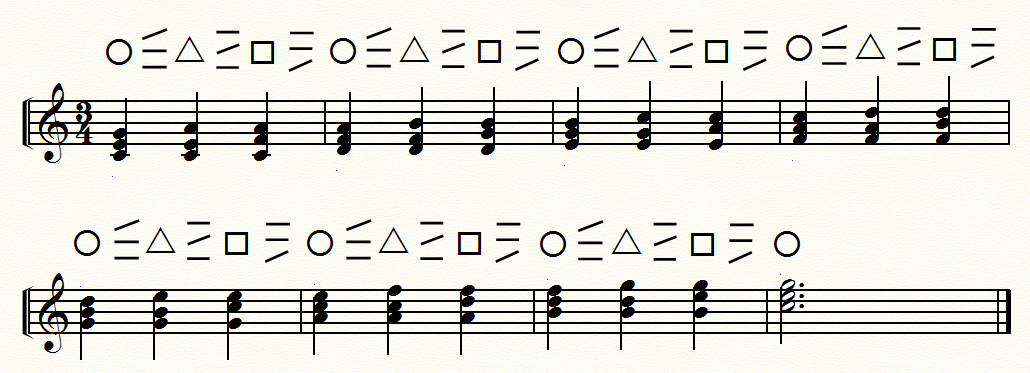
Looking closely, you see that:
- Starting from a root position chord (circle), the top note goes up a step to make a first inversion chord (triangle);
- Then the middle note goes up to make a second inversion chord (square symbol);
- Then the bottom note goes up to get back to a root position chord (circle).
The pattern repeats seven time over a whole octave.
Fingering - Pattern One
The first run-through of Pattern One uses the 'official fingering'.
- Fingers 1-3-5 for a root position chord (circle)
- Fingers 1-2-5 for a first inversion chord (triangle)
- Fingers 1-3-5 (again) for a second inversion chord (square).
The second time, you use fingers 1-2-4 for the root position (circle) chords.
Go ahead and play the pattern. You get a two-bar count-in. With a bit of practice, you should be able to keep up.

Pattern Two ascending in C
In Pattern Two, you:
- Start from a root position chord (circle) but take the top two notes up a step to make a second inversion chord (square).
- Then the middle note goes back down a step to make a first inversion chord (triangle symbol).
- Then the bottom two notes go up a step to get back to a root position chord (circle).
Check the instructions against the voice movement diagrams over the music (below).
The same fingering rules apply - the first time through, use 1-3-5 for the first position (circle) chords. The second time, try it with fingers 1-2-4 for the root position chords.
Try to play Pattern Two ascending in C.
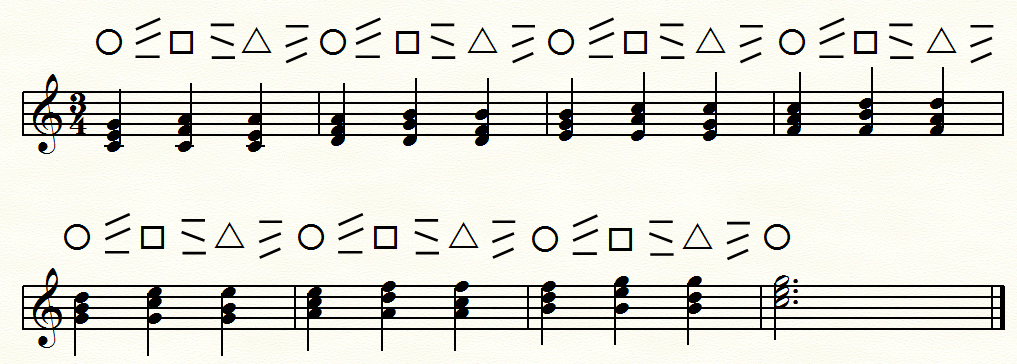
Remember to always use fingers 1-2-5 for the first inversion (triangle) chord.
Pattern One descending in C
Pattern One descending is the exact mirror image of Pattern One ascending.
- Starting from a root position chord (circle), the bottom note goes down a step to make a second inversion chord (square);
- Then the middle note goes down to make a first inversion chord (triangle);
- Then the top note goes down to get back to a root position chord (circle).
The pattern repeats seven time over a whole octave.
In the demonstration video, you get to use first the 'official' 1-3-5 first inversion fingering, then the alternative 1-2-4 fingering (but you don't start with 1-2-4 - that wouldn't make sense).
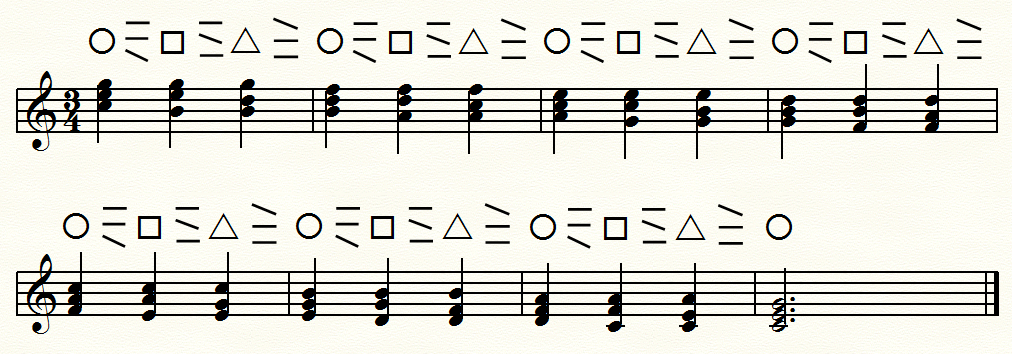
Pattern Two descending in C
In Pattern Two descending you:
- Start from a root position chord (circle) and take the bottom two notes down a step to make a first inversion chord (triangle).
- Then the middle note goes back up a step to make a second inversion chord (square).
- Then the top two notes go down a step to get back to a root position chord (circle).
Play Pattern Two descending in C. Play through once using 1-3-5 for the root position (circle) chords, and once with 1-2-4 (where convenient).
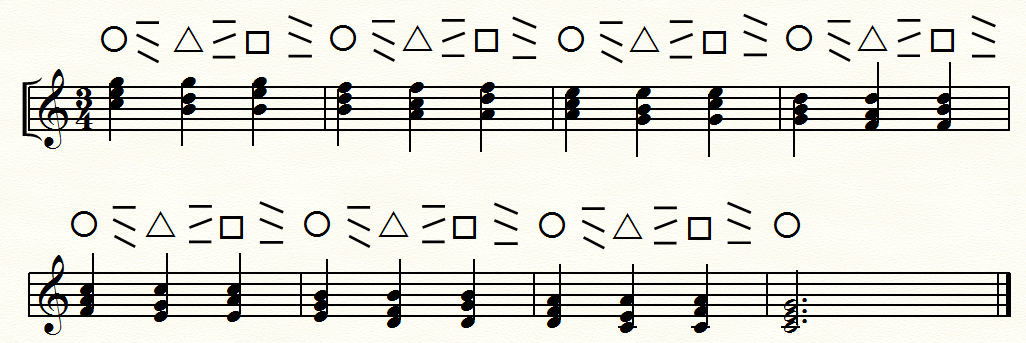
Practice all of these movements several times, patiently, watching carefully for where you have any difficulty.
Then go on to Page Two of the series, where you start playing the drills in key-signature (black-key) keys.
|
OUT NOW! |
THE MUSICARTA BEAT & RHYTHM WORKBOOK At last! An effective approach to keyboard rhythm & syncopation skills. Learn more! |
ONLY $24.95! |
PATREON |
The MusicartaA methodical approach to keyboard syncopation for
|
PUBLICATIONS
exciting keyboard
creativity courses
CHORDS 101
WORKBOOK

~HANON~
video course

Musicarta
Patreon
PENTATONICS
WORKBOOK
video course

Creative Keyboard
video course

BEAT AND RHYTHM
WORKBOOK

- Volume 1 -

12-BAR PIANO
STYLES WORKBOOK

MUSICARTA MODES
WORKBOOK

PIANO STYLE

CANON PROJECT
video course

VARIATIONS
video course


- Piano Solo -
video course

- Piano Solo -


YouTube playlists





 THE LOGO
THE LOGO
